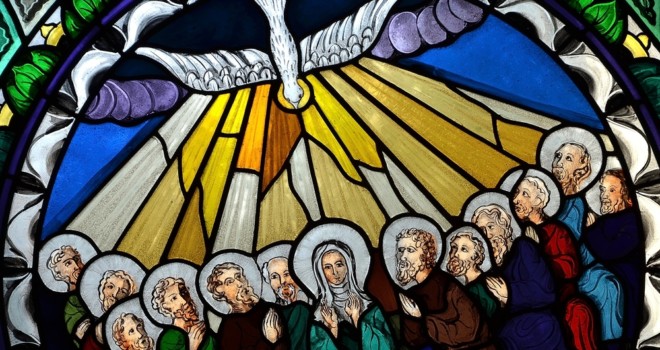After Jesus’ ascension, Pentecost seems to shift the spotlight to the Holy Spirit.
And yet, the fundamental message of Pentecost
centers around the Body and Blood of Christ.
Consider the enduring image we have of Pentecost itself — those tongues of fire that descend from heaven. The image is taken from Isaiah 6, where an angel brings a burning coal from the altar to touch Isaiah’s lips. Isaiah’s tongue if not singed, certainly felt the heat of the fire. The image is seen as a foreshadowing of the Eucharist.
Fire is a symbol of divine nature, hence the burning
bush that Moses saw and the heavenly fire that came upon Mt. Sinai. In
symbolically consuming the fire, Isaiah looks forward to what future Christians
would do, in consuming the divine fire into which the Eucharistic bread has
been transformed.
Another clue comes later in the Pentecost account, when some onlookers conclude that the apostles “have had too much new wine.” Spiritually this is what happens to us in receiving the Eucharist. As the old Anima Christi prayer goes, Blood of Christ, inebriate me.
But the relationship between Pentecost and the
Eucharist goes even deeper. One interpretation of the account of Pentecost is
that it is the descent of the heavenly temple on earth. There are three ways in
which Pentecost is connected to the temple. First, Pentecost is a reversal of
Babel, in which mankind tried to build his own temple to reach heaven. Just as
man was dispersed into a multitude of tongues so now in Pentecost the many
tongues of man are brought into one.
Second, a number of parallels tied Pentecost to the dedication of the temple by Solomon in 1 Kings 8. These links in turn lead us back to the exodus account of Mt. Sinai, where Moses had to ascend the mountain to reach the cloud and fire, which was a manifestation of the heavenly temple. (I’ve offered here just the briefest of synopses. Check out my previous article on this topic for more.)
In Pentecost, unlike Babel, the temple descends and is the work of God. Unlike Solomon, the temple is spiritual not physical. In contrast to Mt. Sinai, man no longer needs to ascend the mountain to reach God. God has come to Him.
That Pentecost is about the temple has obvious
implications for the Eucharist. What happens in temples? Sacrifices. This is
what the Eucharist is—a living, bloodless memorial of Christ’s sacrifice. And
Pentecost was, by the way, a harvest festival on the Jewish calendar.
This interpretation of Pentecost seems confirmed by
the context. In Acts 1,
we see no mention of the breaking of bread by the apostles. But suddenly, after
the descent of the Spirit in Acts 2,
this seems to be a focal point of their activity.
Acts 2 makes two mentions of the breaking of bread,
plus two additional references to communion and the common life of the
Christians. One verse is particularly telling:
Every day they devoted themselves to meeting together in the temple area and to breaking bread in their homes (verse 46).
In his apostolic exhortation, Sacramentum Caritatis, Pope Benedict XVI confirms the Eucharistic
importance of Pentecost:
In
the account in Acts, the Spirit descends on the Apostles gathered in prayer
with Mary on the day of Pentecost (cf.
2:1-4) and stirs them to undertake the mission of proclaiming the Good News to
all peoples. Thus it is through the working of the Spirit that Christ himself
continues to be present and active in his Church, starting with her vital
centre which is the Eucharist.
In a way, every Mass is a little Pentecost. For in
the second Eucharistic Prayer the priest says the following:
Make holy, therefore, these gifts, we pray,
by sending down your Spirit upon them like the dewfall.
Dewfall, as one writer notes, is hidden and subtle — it is not nearly as dramatic as a heavenly wind and tongues of fire. But the reality is the same: in the Mass, the Holy Spirit descends from heaven to bring us into union with Christ.
✠
image: piosi / Shutterstock.com












